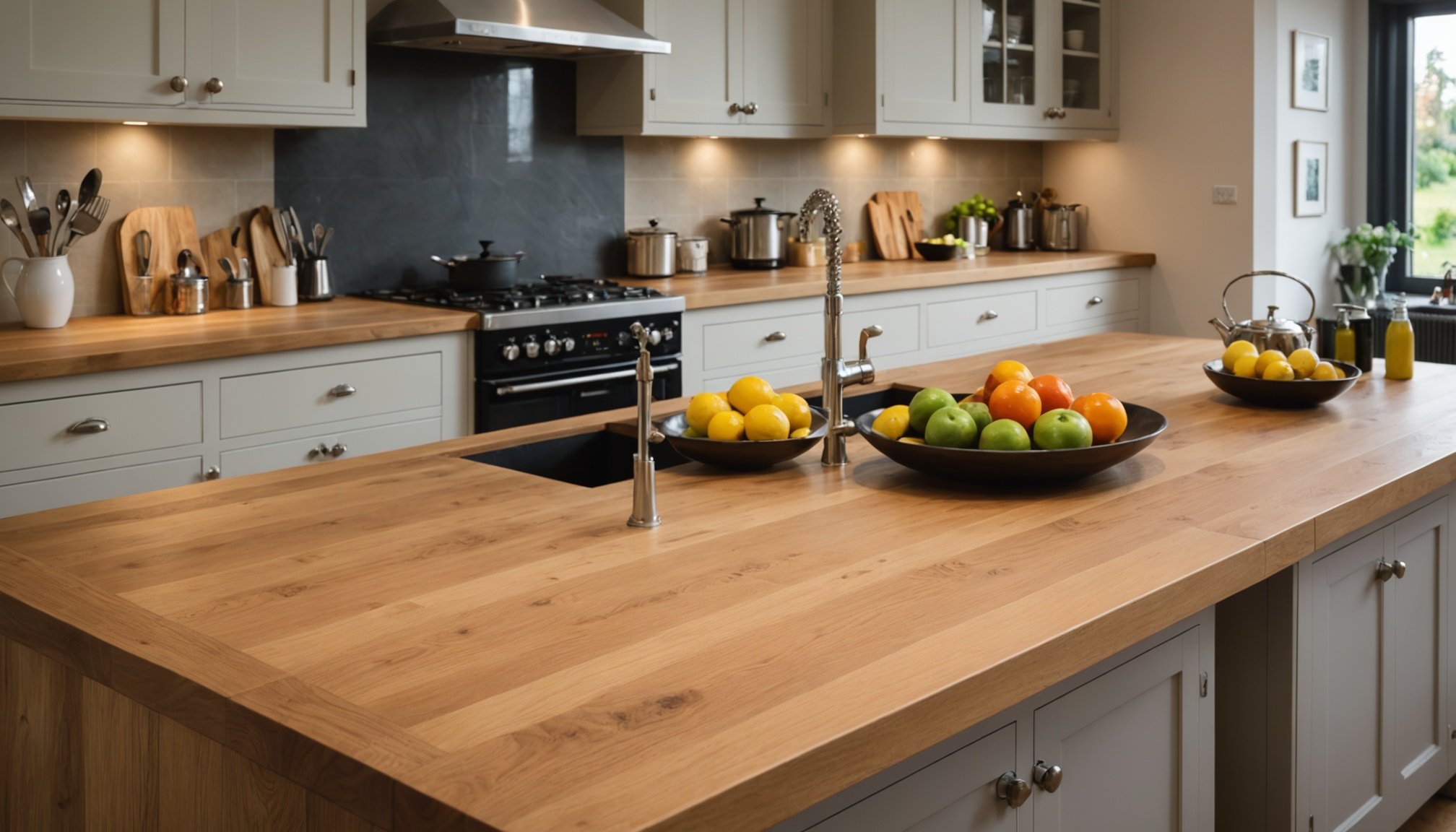Overview of Oak Worktops
Oak worktops have become a cornerstone in UK kitchens, offering both practicality and beauty. Oak, as a material, brings a timeless charm and durability that is highly valued in many households.
Benefits of Using Oak Worktops
One major advantage of oak worktops is their robustness. Oak is naturally a strong hardwood, making it resistant to everyday wear and tear, which is essential in a busy kitchen environment. Furthermore, oak worktops provide an elegant aesthetic, adding warmth and sophistication to any kitchen space.
In parallel : Top Homeowner Tips: Elevate Your Kitchen’s Air Quality in the UK
The aesthetic value of oak is further enhanced by the variety of styles and finishes available. Homeowners can choose from a range of shades, from light honey tones to deep, rich browns. Each finish can complement different kitchen styles, whether modern or traditional. The versatility of oak ensures that it can seamlessly fit into various kitchen designs.
Besides the visual appeal, oak worktops are easy to maintain. Regular oiling not only preserves their rich look but also enhances their moisture resistance. This dual advantage of aesthetics and practicality makes oak a favored choice among UK homeowners.
Also to read : The Ultimate Guide to the Best Under-Sink Water Filtration Solutions in the UK: Top Brands Revealed
Regular Maintenance Procedures
Regular maintenance is essential to ensure the longevity of oak worktops. Establishing a routine helps maintain their natural beauty and durability.
A daily cleaning routine is one of the most straightforward ways to preserve oak worktops. This involves wiping the surface with a damp cloth and mild soap. It’s crucial to avoid excessive water, as oak is prone to water damage.
When considering cleaning products, opt for pH-neutral cleaners. These are gentle and effective, ensuring the worktop continues to look its best without added risk. Avoid any harsh chemicals such as bleach or ammonia-based products. These substances can strip the finish and damage the wood fibers over time.
In addition to daily cleaning, employing the correct techniques is equally vital. Always wipe along the grain of the wood. This prevents snagging and ensures grime is lifted away rather than pushed into the surface.
Regular maintenance not only keeps your oak worktop clean but significantly extends its life. By adhering to these routine maintenance practices, you can enjoy the timeless elegance of your oak worktops for years to come.
Preventative Care Strategies
Protecting oak furniture from wear and tear is essential to maintaining its beauty and longevity. Preventative care involves a few simple practices to ensure your oak remains in top condition.
Using coasters and mats is a practical technique for protecting oak surfaces. Place coasters under glasses and mats under hot dishes to prevent moisture-related damage such as rings and stains. This step is effective in keeping the surfaces pristine and unblemished over time.
Another key aspect of oak care is moisture control. Maintaining optimal humidity levels in your home prevents the wood from swelling or cracking. Use a humidifier during dry seasons and a dehumidifier in more humid periods to sustain balance. This approach reduces the risk of damage due to fluctuations in moisture.
Additionally, avoiding scratches and dents requires some thoughtful measures. Feel free to use protective pads under heavy items and avoid dragging them across the wood. If possible, rotate the items routinely to distribute weight evenly. Engaging in these habits helps safeguard the oak from unsightly marks.
Implementing these preventative care strategies not only preserves the appearance of your oak furniture but also extends its lifespan, ensuring your investment remains valued for years to come.
Restoration Techniques for Damaged Worktops
Restoring a damaged oak worktop can often be accomplished with simple repair methods. The first step is to identify the type of damage. Common issues include scratches, burns, and water stains. Once the damage has been specified, repair methods can be selected accordingly.
For minor damage fixes, you can often tackle the worktop restoration yourself. Begin by cleaning the surface thoroughly. For scratches, sanding the area with fine-grit sandpaper can reduce visibility. Apply a matching wood filler and sand again once it is dry. For burns, it may be necessary to sand deeper and reapply oil or sealer to blend the repaired area with the rest of the worktop.
Water stains can usually be eliminated by lightly sanding followed by applying lemon oil or vinegar to the affected area. However, these DIY repair methods may not suffice for severe damage or when the finish involves complex material.
In cases of extensive damage, seeking professional restoration services is advisable. Professionals use advanced techniques tailored to preserve the integrity and aesthetic of oak worktops. Investing in expert restoration ensures longevity and optimal appearance, effectively addressing intricate concerns beyond amateur repair scopes.
Product Recommendations for Oak Worktop Care
Choosing the right products for the maintenance of oak worktops is critical to extend their lifespan. When it comes to cleaning products, opt for those specifically designed to protect wood surfaces. A gentle, non-abrasive cleaner is ideal, preventing scratches and preserving the natural beauty of the oak.
Protection is paramount, and here, oils play a vital role. Linseed and Danish oils are highly recommended for their ability to penetrate deeply, enhancing the grain while providing a robust seal against moisture. For those seeking a more natural approach, eco-friendly oils offer similar benefits with the added advantage of being kinder to the environment.
The choice of protectants often boils down to preference and priorities. Traditional finishes, such as polyurethane, deliver a durable shield but may limit the wood’s ability to ‘breathe’. In contrast, waxes and oil-based finishes allow for a natural ageing process, showcasing the oak’s inherent characteristics.
In evaluating the options, consider factors like ease of application, drying times, and environmental impact. A balance between effective protection and sustainability could lead you to try more eco-conscious waxes or oils, ensuring your oak worktops remain a stunning focal point in your kitchen.
Expert Tips and Insights
Taking care of oak worktops involves more than just routine cleaning. It’s essential to avoid common mistakes in oak care to ensure their longevity. Professional insights often underline the importance of avoiding excessive water exposure, as water can warp and stain the wood. Homeowners frequently share experiences about the challenges of preventing scratches and heat marks. Placing coasters under hot pans and using chopping boards are simple yet effective strategies against these issues.
Maintenance may also require tailored strategies throughout the year. Seasonal changes significantly impact oak worktops. In winter, the air becomes drier, potentially causing the wood to contract. Professionals often advise using humidifiers to maintain optimal moisture levels. During summer, it’s crucial to regularly oil the worktops to protect them against sun-induced warping.
For daily maintenance, expert advice includes wiping spills immediately and using gentle, non-abrasive cleaners. This approach prevents surface damage and keeps the natural shine intact. Homeowners who meticulously follow these maintenance tips often report fewer problems and enjoy their oak worktops’ timeless beauty for years. Thus, a comprehensive understanding and application of expert oak care significantly contribute to preserving both the aesthetic and functional quality of oak worktops.








